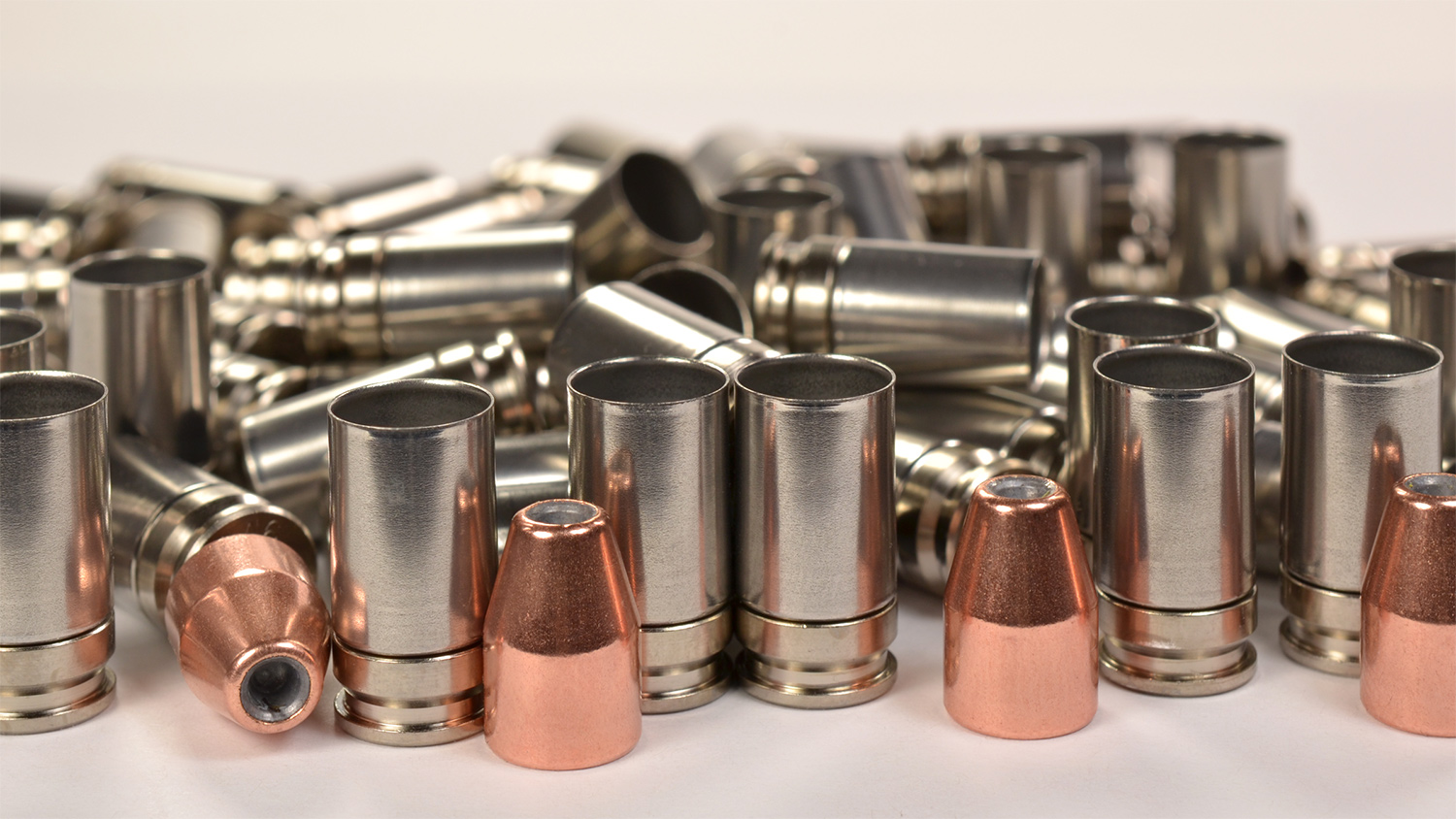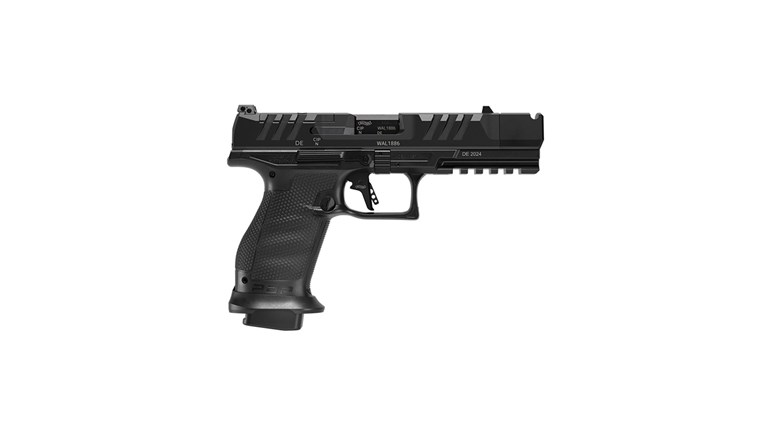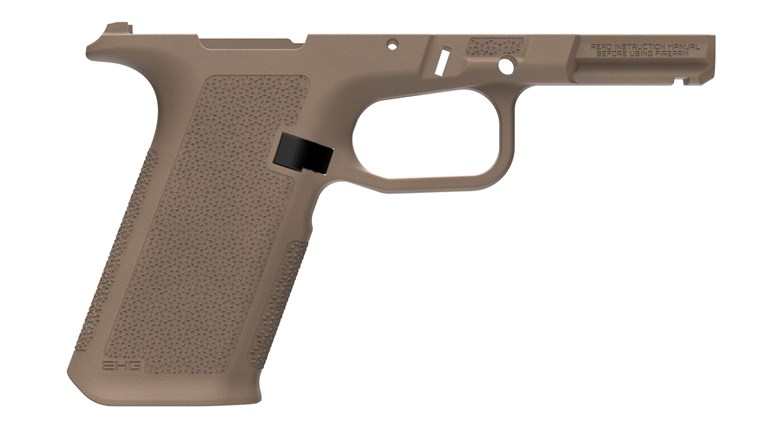
WARNING: All technical data in this publication, especially for handloading, reflect the limited experience of individuals using specific tools, products, equipment and components under specific conditions and circumstances not necessarily reported in the article and over which the National Rifle Association (NRA) has no control. The data has not otherwise been tested or verified by the NRA. The NRA, its agents, officers and employees accept no responsibility for the results obtained by persons using such data and disclaim all liability for any consequential injuries or damages.
Shell Shock Technologies new two-piece designed 9mm Luger case is showing up in more and more factory ammunition. This innovative design has a nickel alloy stainless cylinder body attached to a nickel-plated aircraft-grade aluminum base.

The Nickel Alloy Shell (NAS3) cases have purported advantages over conventional brass cases. They are 50 percent lighter, less abrasive, self-lubricating, corrosion resistant, and won’t split, chip or crack, and they’re magnetic so you can pick them up with a magnet.
Reloading NAS3 cases is no different than loading brass cases, with the exception of requiring a special sizing die and flaring die made by S3 Reload. The cases require lubrication for the sizing stage, even though the special sizing die has a carbide insert. The sizing die can be used with regular brass cases, as well.
Shell Shock claims they are stronger than conventional brass cases and have a 65,000 psi pressure rating. This caught my eye, and one of the things I wondered was whether they could be used for very high pressure loads such as 9 Major.
We often think the powder chamber contains the bulk of the peak pressure, but the pressure also pushes back on the primer through the flash hole. If the pressure is too high, the primer metal will show signs of stress by flattening and flowing, and the primer hole can be stretched, making it too loose to be used again.
I wondered how the primer pocket in the NAS3 case’s aluminum head would hold up to very high pressure. Brass cases, when loaded to very high pressure, can, in just a few uses, end up with loose primer pockets. Shooters who load 9 Major for competition, where the pressures can easily exceed 9mm +P pressures, can end up with loose primer pockets after just a couple of loadings.
The durability of the NAS3 cases’ primer pockets was tested by firing high pressure loads in new cases then re-priming them to assess how “loose” the primer pockets were.
The first high pressure load was a published +P load in the Western Powders manual. This was a 115-grain jacketed bullet seated to 1.1-inch over 6.2 grains of True Blue powered with CCI 500 primers. The Western manual indicates that this load produced 38,373 psi and 1197 fps in their 4-inch test barrel. This load clocked at 1277 fps from my 4.6-inch Lone Wolf barrel and 1295 fps from my 5-inch Kart barrel.
The +P load was fired four times in the same NAS3 cases. The primer pockets were in good shape. They were not as tight as new cases, but they were not loose.
A second high pressure test was conducted by loading cases to 9 Major performance levels. Nine Major (or Major 9) is a term used by competitive shooters who load 9mm Luger ammunition to meet a specified power level required in USPSA/IPSC competitive shooting sports for Open Division pistols (usually having a compensator and optical sight). Power factor is defined by bullet weight times velocity divided by 1000. In USPSA, Major power factor is 165, which means a 115-grain bullet must go at least 1435 fps to qualify. Most shooters load their ammo to around 170-172 power factor to make sure it meets the requirement. These velocities and pressures usually far exceed common 9mm Luger performance and should only be loaded by very experienced reloaders and only fired in guns specially designed for this type of ammunition. The chamber pressures of 9 Major can be extremely high with some loads and can exceed the SAAMI pressure limits of 38,500 psi for 9mm +P.
A test was conducted to check the velocity of loads in NAS3 cases compared to conventional Starline 9mm brass cases. Both cases were loaded with Federal small rifle (205) primers, 7.8 grains of AutoComp and a 115-grain Winchester JHP bullet seated to 1.150-inch overall length. They were fired from a Glock 19 with a 4.6-inch Lone Wolf barrel. The load in Starline brass produced an average of 1521 fps, and the load in NAS3 cases was faster with an average of 1577 fps. Curiously, the NAS3 cases have slightly more internal capacity than Starline cases, so one would predict that the NAS3 cases would produce slightly less speed. However, that was not the result, and I’ve compared these same two cases with standard pressure loads and the NAS3 cases reliably produced higher speeds with the same load.

A load was developed in Shell Shock cases using 7 grains of Winchester AutoComp and a Zero 115-grain FMJ bullet seated at 1.150-inches OAL. This load produced 1475 fps (169 power factor) in the 4.6-inch Lone Wolf barrel and 1521 fps (175 power factor) in the 5-inch Kart barrel. Thirty seven percent of these cases had primer pockets that were too loose to safely hold a new primer after just one firing. The primer pockets in the remaining cases were noticeable looser than new cases, but were still tight enough to be used again—although I would hesitate to use them for this same high pressure load.

AutoComp is one of the faster burning powders used for 9 Major. A second series of 9 Major ammunition was loaded with Accurate #7, a slower burning powder. This powder should, in theory, be able to reach the same power factor level as AutoComp but at lower pressure.
Four different charge weights (9.0, 9.3, 9.6 and 9.9 grains) of Accurate #7 were loaded in 10 new cases each with 115-grain Hornady HAP bullets at 1.150-inches OAL. The rounds chronographed from the 5-inch Kart barrel at 170, 176, 179, and 183 power factor, respectively (1477, 1533, 1553 and 1594 fps, respectively). None of the 170 power factor cases had loose primer pockets, though many were not as tight as new cases. One of the 176 power factor cases had a primer pocket too loose to trust with future loads, but the remaining cases were fine. None of the 179 power factor cases had loose primer pockets. With the 183 power factor cases, one primer pocket was a little loose but would probably handle a standard pressure load. One primer was so loose that it fell out during handling! The primer pockets in the remaining eight cases were not as tight as new cases, but were still reasonably tight.

These extreme pressure tests show that NAS3 cases can be used for high pressure and 9 Major loads, but depending on the powder and the performance level required, the primer pockets might be loose after a single or a few loads, just like brass cases.


































